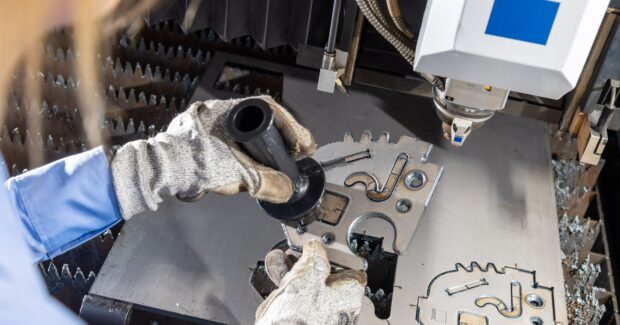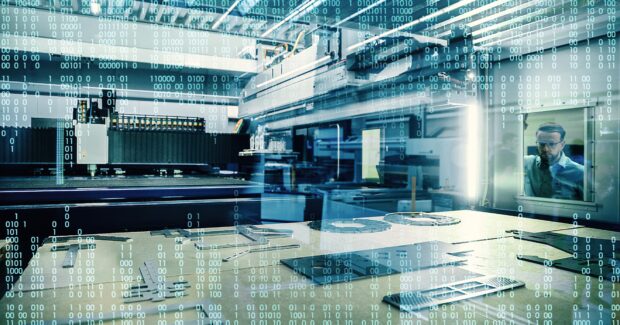Artificial Intelligence Joins the Fabrication Shop
AI-based assistants will not only help factories operate in a smarter way, but they will also have a dramatic impact on manufacturing profitability as well.
Posted: June 11, 2024

Although artificial intelligence, or AI, is a “hot topic” right now, it certainly is not new. AI has been advancing incrementally and used for research and other endeavors for a long time. Computer scientists have been defining and building the concepts behind what we generally refer to as AI for decades. So, why is everyone talking about AI on the shop floor? Let’s take a closer look.
First, let’s define what we mean by AI. The definitions of AI are detailed and complex in practice, but in simple terms for a general discussion, AI could be described as a system (with a hardware and software component) that emulates human thinking. We could further define “thinking” as our ability to learn information, analyze what we have learned, and apply the lessons to decisions that we need to make. Less advanced AI models can do simple sorts of thinking and reasoning, within more narrow parameters, whereas complex AI models can learn and reason in a way strikingly similar to humans and across a wide range of situations.
There are many types of AI being developed to operate in different types of ways. One example, large language models, or chatbots as they are often called, have become quite well-known and essentially allow programs and people to interact using natural language, without needing a special language (i.e., code) to exchange information.
It is clear to anyone observing the advance of computer science that intelligent programs have tremendous power to assist us in our daily lives. The change will be so revolutionary that the closest likely analogue in our recent history is the harnessing of electrical power to do work. Electricity gave rise to the world of lights, motors, and refrigeration in which we live today. Just as harnessing electrical power to do mechanical work completely transformed the way that factories organized and operated in the 20th century, so too is AI technology likely to drive the way that people work in factories during the 21st century.
The need for any technology developer to adopt AI support seems evident, and as a machine builder, TRUMPF is no exception. While simpler AI protocols have been around in the machine tool industry for some time, they have generally been the kind that can only respond in a limited way to a limited number of input situations. Such simple sorts of intelligent machine functions might, for example, observe a machine process with an optical vision system and look for specific defects or deviations in the process. This type of intelligent program can recognize certain kinds of information, like a defective cut on a part, and respond in very certain ways, such as slowing down, interrupting, or restarting the machine process.
More advanced AI models have the ability to continuously learn based on feedback. Such systems are also making their way into widespread use as well. These powerful virtual assistants are already having a significant impact.
With industrial machinery, safety and reliability are very important. Any system that might interact directly with moving parts and people in the real world needs to be very carefully tested. This certainly applies to AI processes as well. One of the first areas where TRUMPF adopted advanced learning algorithms was in the final assembly of machines. This allows the technology, both hardware and software, to be tested internally with working procedures that employees will use every day.
One very interesting development at TRUMPF has been an acoustic input system coupled with an AI trained to “listen” exceptionally carefully to sound information. When the sensitive listening device is mounted to a machine in testing — a machine with moving parts that all vibrate in a specific way during operation — it is possible to map all the various sounds the machine makes when it moves: Gears turning, relays clicking, bearings rolling, slides slipping, spools spinning. If you then feed that very detailed sound information into an algorithm that can interpret every slight variation in the data, it becomes possible to detect extremely small anomalies in the movement of any given machine, based on comparing its sound map to other maps. The upshot of this technology is the ability to detect things like missing pieces, improperly connected fittings, loose fasteners, sticking bearings, and a whole host of other very small imperfections that a human at a testing station could overlook. The technology works so well in identifying tiny error modes that it will also become an integrated tool in new machines to allow “acoustic troubleshooting” of the machine during its working life. In this way, AI will soon be helping to detect issues and reduce unplanned downtime in factories everywhere.
AI Partner Advises on Best Practices
Going beyond internal use at the company, TRUMPF has also been working to develop a novel AI-driven solution to an extremely common sheet metal fabrication challenge: How to design sheet metal components and assemblies for cost-effective manufacturing, and how to train new designers on these principles. For a long time, it has been something of an axiom in metal fabrication that designers rarely understand how the products they design will be made, and sometimes the design of a sheet metal part or assembly creates serious difficulties in the manufacturing process. A classic example of this would be designing bent flanges that are difficult (or even impossible) to form correctly in a fabrication process. Getting designers trained on what designs are feasible for manufacturing is a time-consuming process, and learning what designs are not just feasible, but also economical, can be even trickier.
Enter an AI partner that can advise you on best practices of design for manufacturability, and even recommend design changes that can reduce manufacturing costs. This is exactly what a special program developed by TRUMPF will be able to do for fabrication machinery users. The AI model can work directly with CAD designs, receiving 3D models of components and assemblies as input data and providing analysis and recommendations for the design. The algorithm has been trained on thousands of examples of manufacturing standards to give it a broad understanding of different types of sheet metal designs and what the different manufacturing constraints are.
Instead of relying on “tribal knowledge” to get engineers up to speed on the manufacturing process, the AI program can work as a virtual experienced partner and guide the designer on how to create feasible and economical sheet metal parts. The future development of this system will include the ability to train the algorithm with real-world production data from the shop floor, for example, giving information back to the algorithm about which cutting programs resulted in tipping parts during the machine process and which didn’t. This feedback loop — from design to manufacture and back — will allow the program to predict more accurately which design elements may cause a problem on the factory floor so they can be addressed in advance.
With such developments already coming into play today, it is a convincing argument that AI-based assistants will not only help factories operate in a smarter way very soon; AI will also have a dramatic impact on manufacturing profitability as well.

















